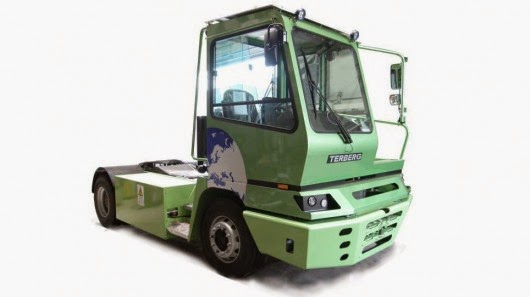With its all-electric i3 urban car hitting the road in 2013, BMW is now going bigger – much bigger. The Bavarian automotive giant has just announced that as part of a one-year pilot project, a 40-ton (36-tonne) all-electric drive truck will begin making deliveries on public roads in Munich from mid-year.
In an odd way, trucking companies and truck manufacturers are at the leading edge of environmental technology. Sure, you think of them as the big, slow-moving things holding up traffic, or the conveyance by which your Amazon purchase ends up at your door, but the people that build trucks and the people who use trucks are seemingly just as concerned about fuel efficiency and lowering pollution as your average granola-munching environmental activist.
A person doesn't have to think too long or hard to realize that fuel costs are going to be both a big concern for trucking companies, and also one of the areas where improved efficiency will reap great benefits. This is not a new notion. Navistar rolled out a hybrid drive truck back in 2008, and Fuso has been running a heavy-duty hybrid since 2011, while Coca-Cola has been using 120 Eaton diesel-electric hybrid trucks since 2008. Even Volvo is in on the act, with a diesel-electric hybrid truck that it claims is the world's fastest.
Enter BMW. Although primarily known as a maker of high-performance motorcycles and sedans, BMW is no stranger to the world of environmentally-sensitive hybrid-powered vehicles, having already released its i8 and recently displaying its upcoming X5 xDrive40e hybrid SUV. But what BMW just announced is worlds removed from its normal offerings.
BMW is partnering with a German logistics company, the SCHERM Group, to set up and use a 40-ton all-electric truck this summer, making BMW the first automobile manufacturer in Germany to use an electric semi-truck to transport goods on public roads.
The truck is based on the Terberg Type YT202-EV 4x2, which BMW has licensed for road use so it can be used for just-in-time material transport covering a distance of almost 2 km (approximately 1.2 miles) one-way between SCHERM Group facilities and the BMW Plant in Munich – a trip it is expected to make eight times a day. Sure, that's only 16 clicks a day, but you've got to start somewhere, and this is serious lifting we're talking about, not light package runs.
Thanks to the all-electric drivetrain, the BMW truck is quiet, CO2-free and produces effectively no particle pollution. If you compare that to a normal diesel truck, it's almost laughably good. The new electric truck will generate 11.8 tons (10.7 tonnes) less CO2 per year. That's the amount of CO2 put out by a BMW 320d diesel sedan after three around-the-world trips.
Both BMW and SCHERM are investing a six-figure amount in this one-year pilot project. If the big truck proves itself in everyday driving circumstances, both partners seek to expand the project.
Source: BMW

Comments
Post a Comment